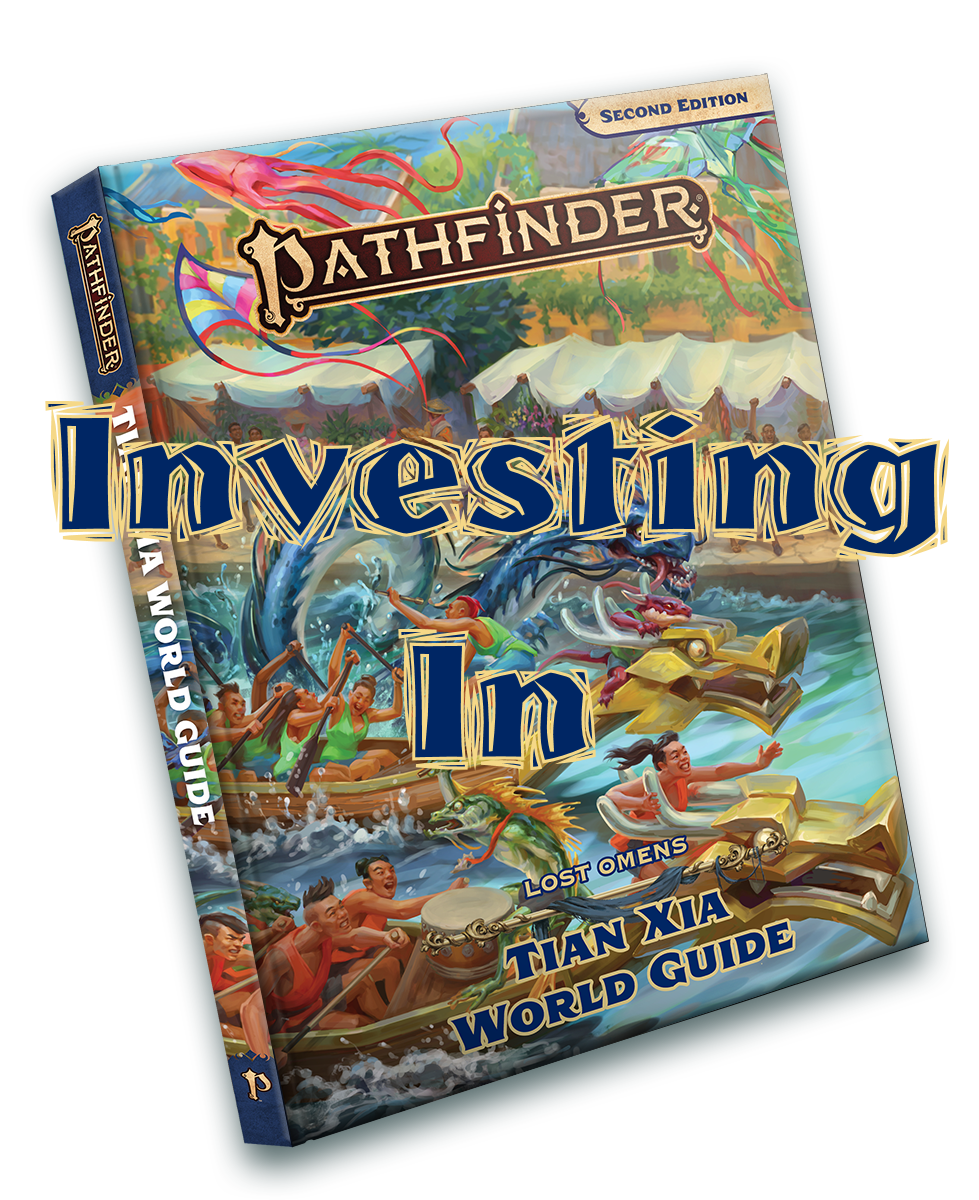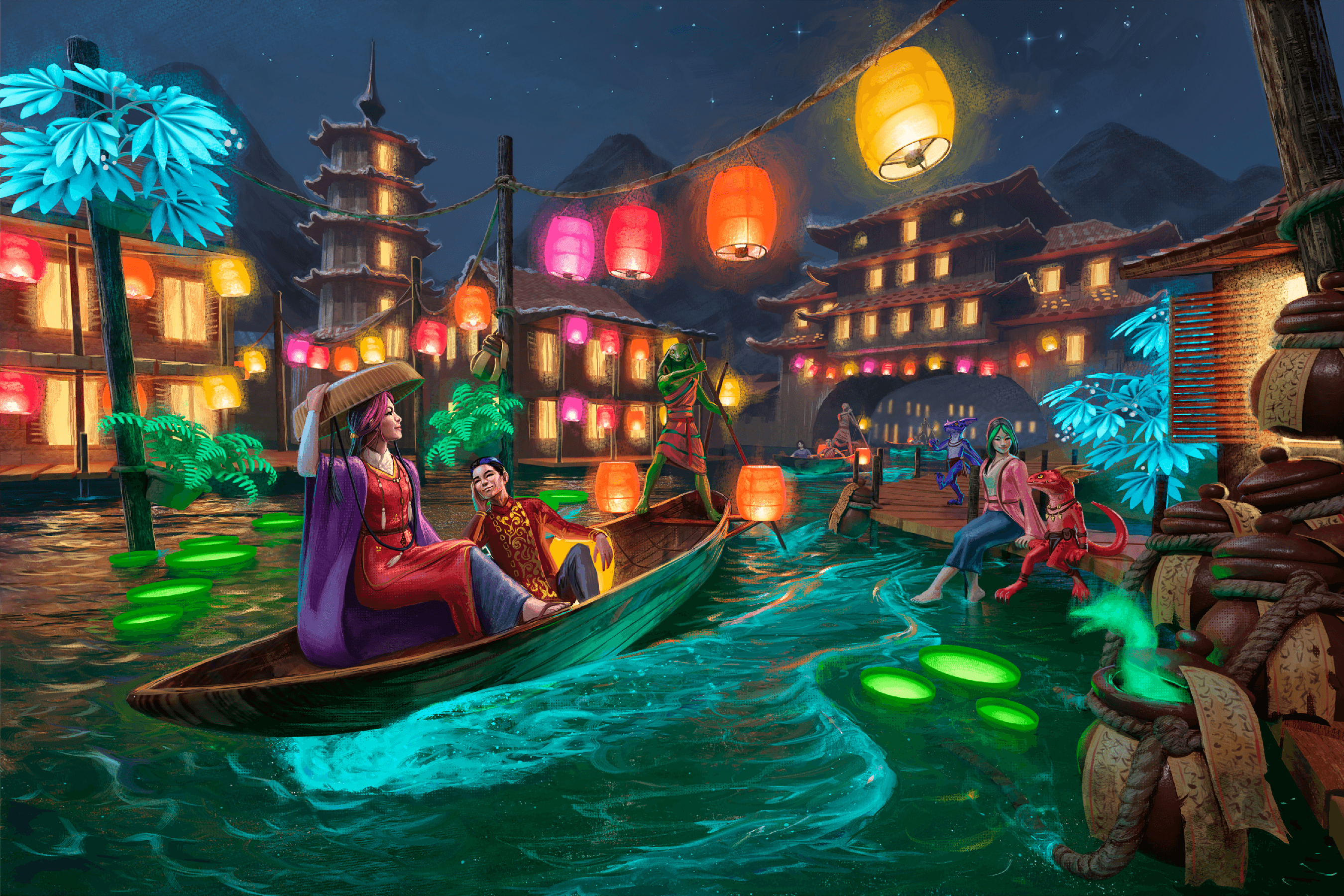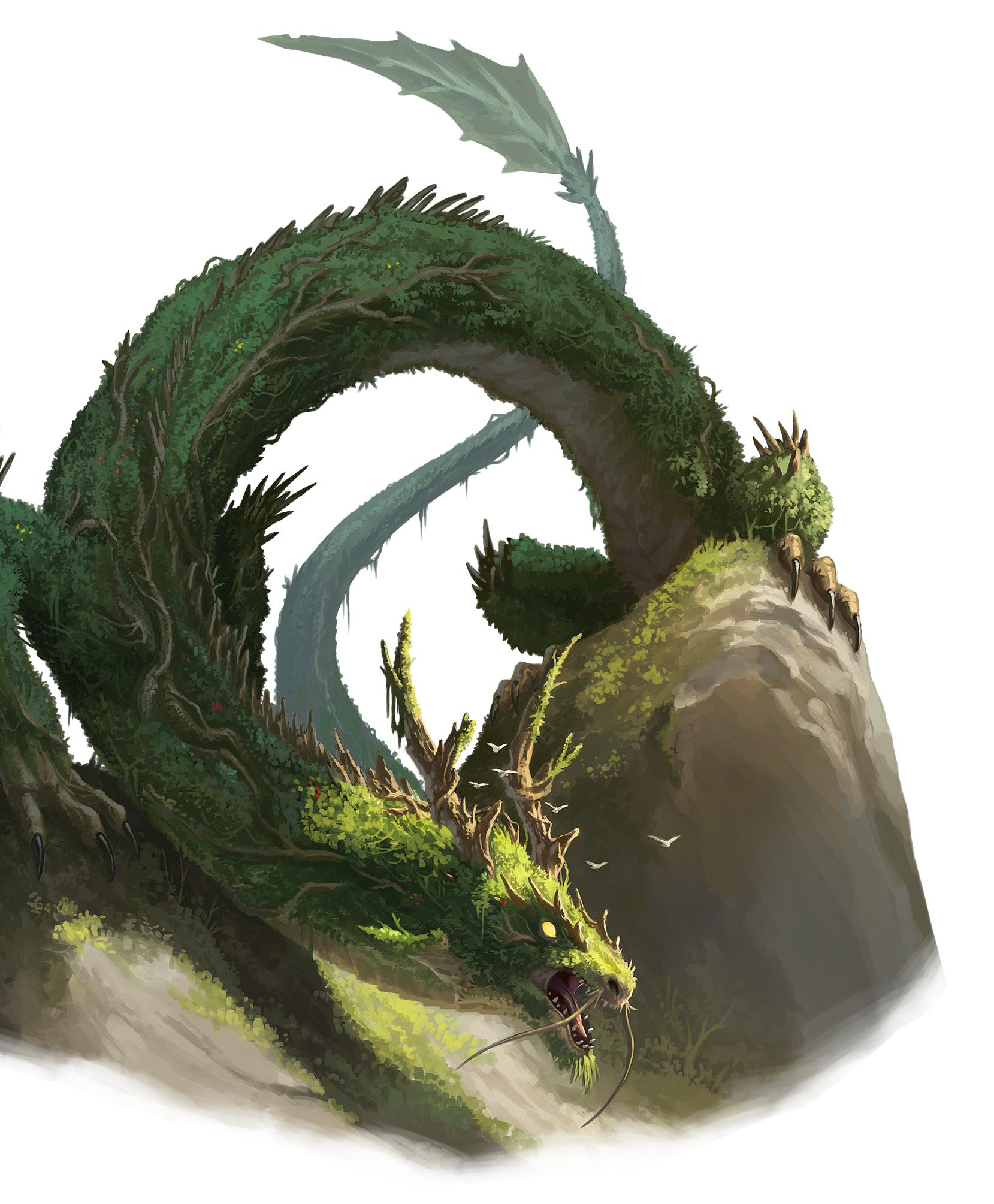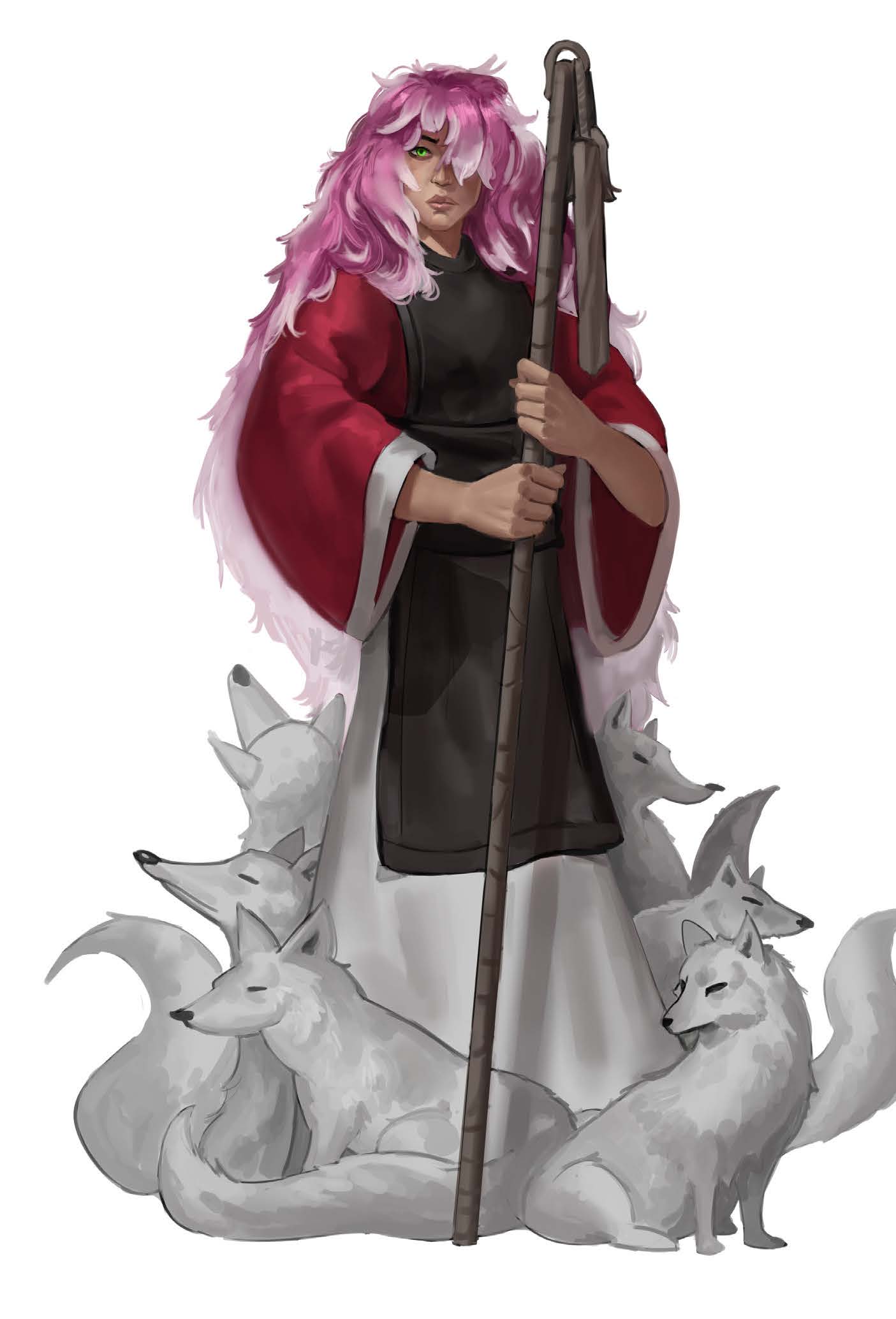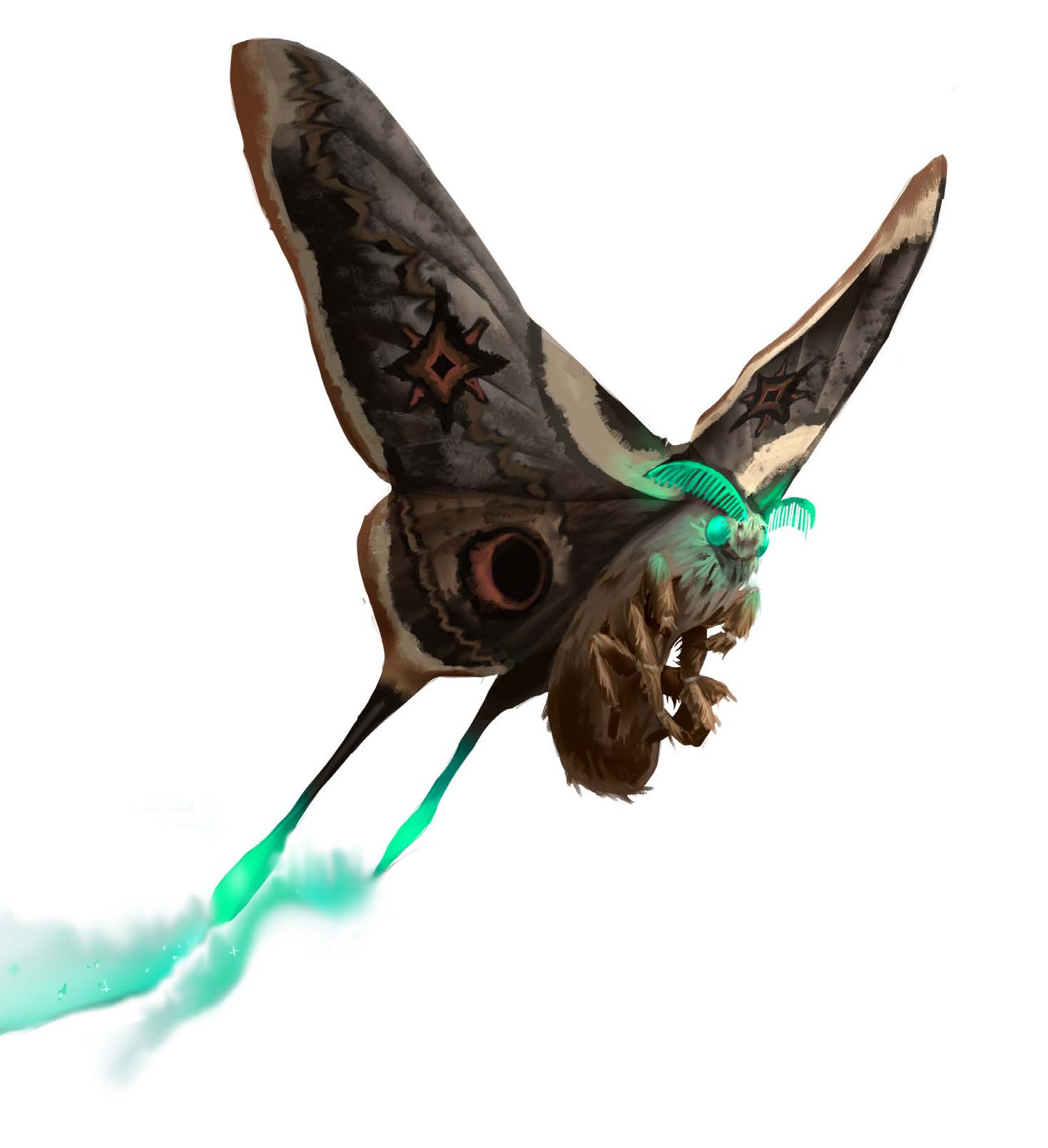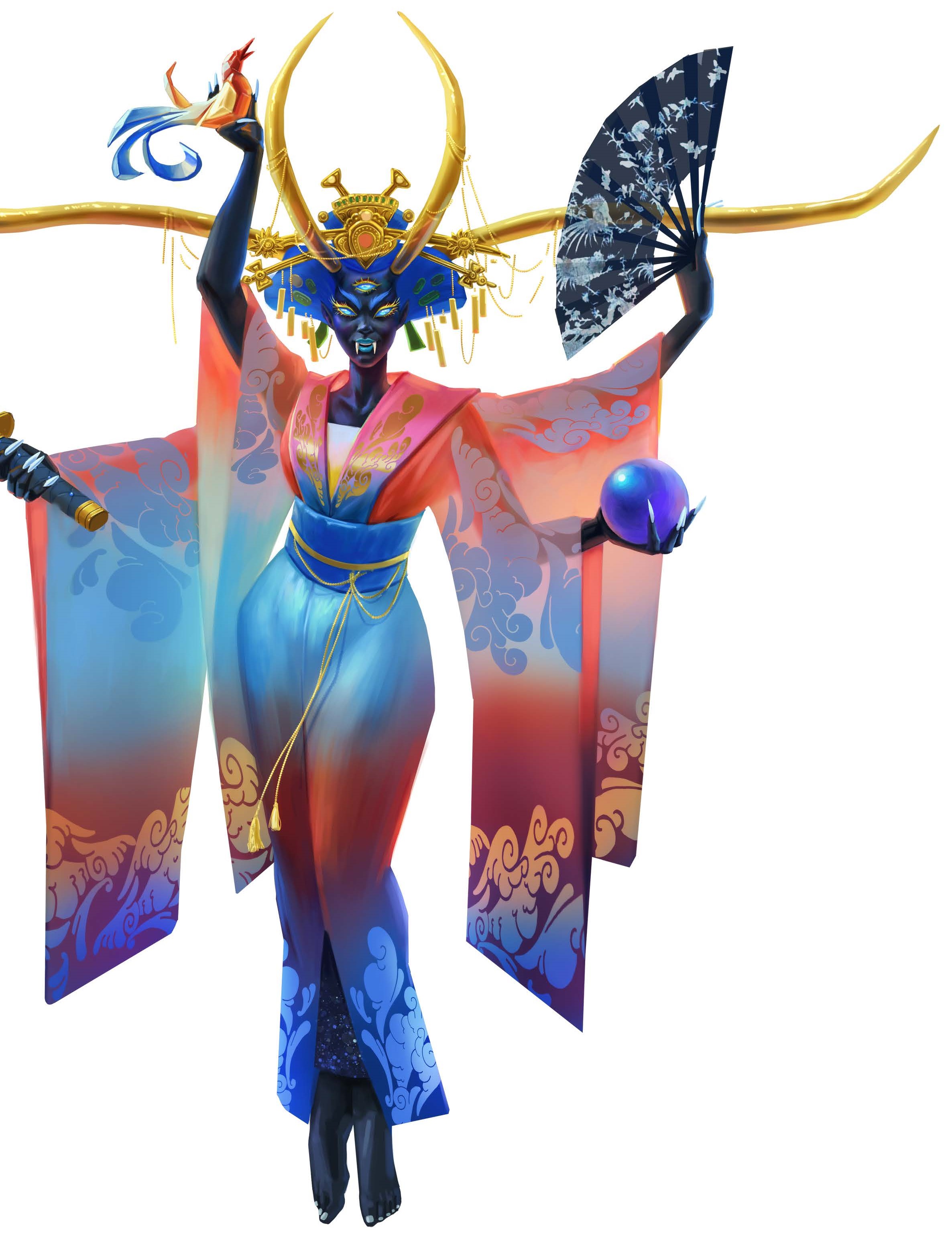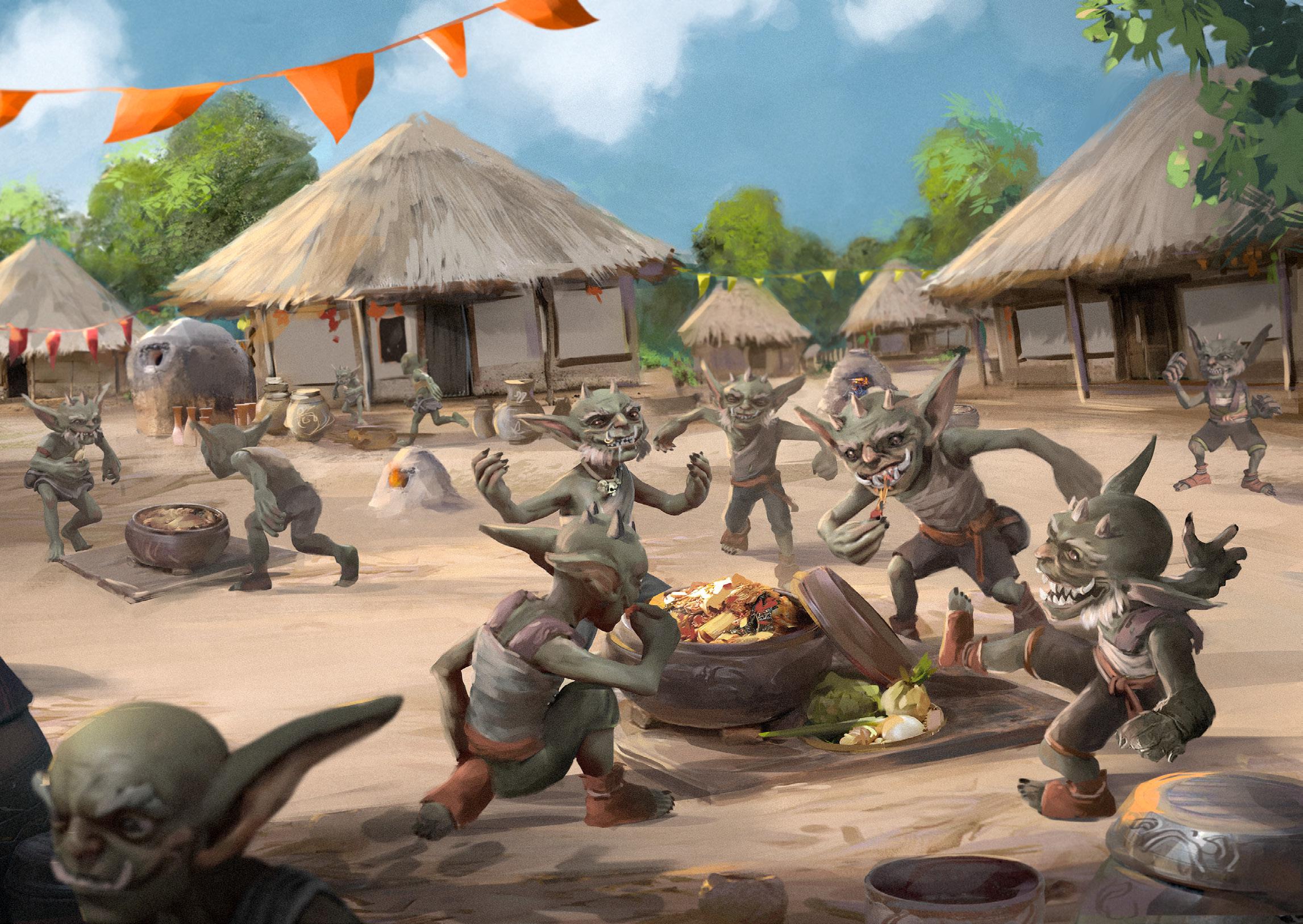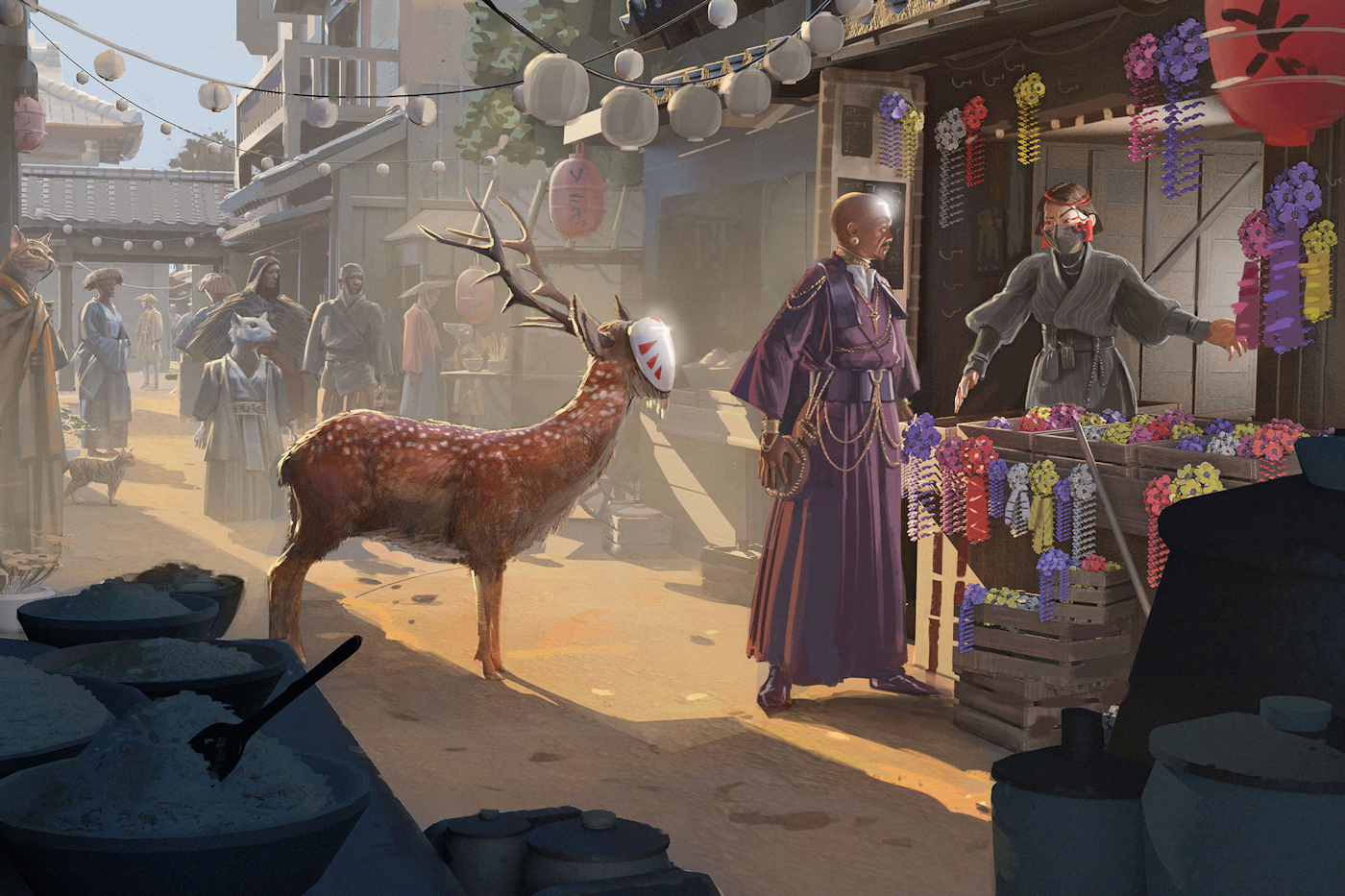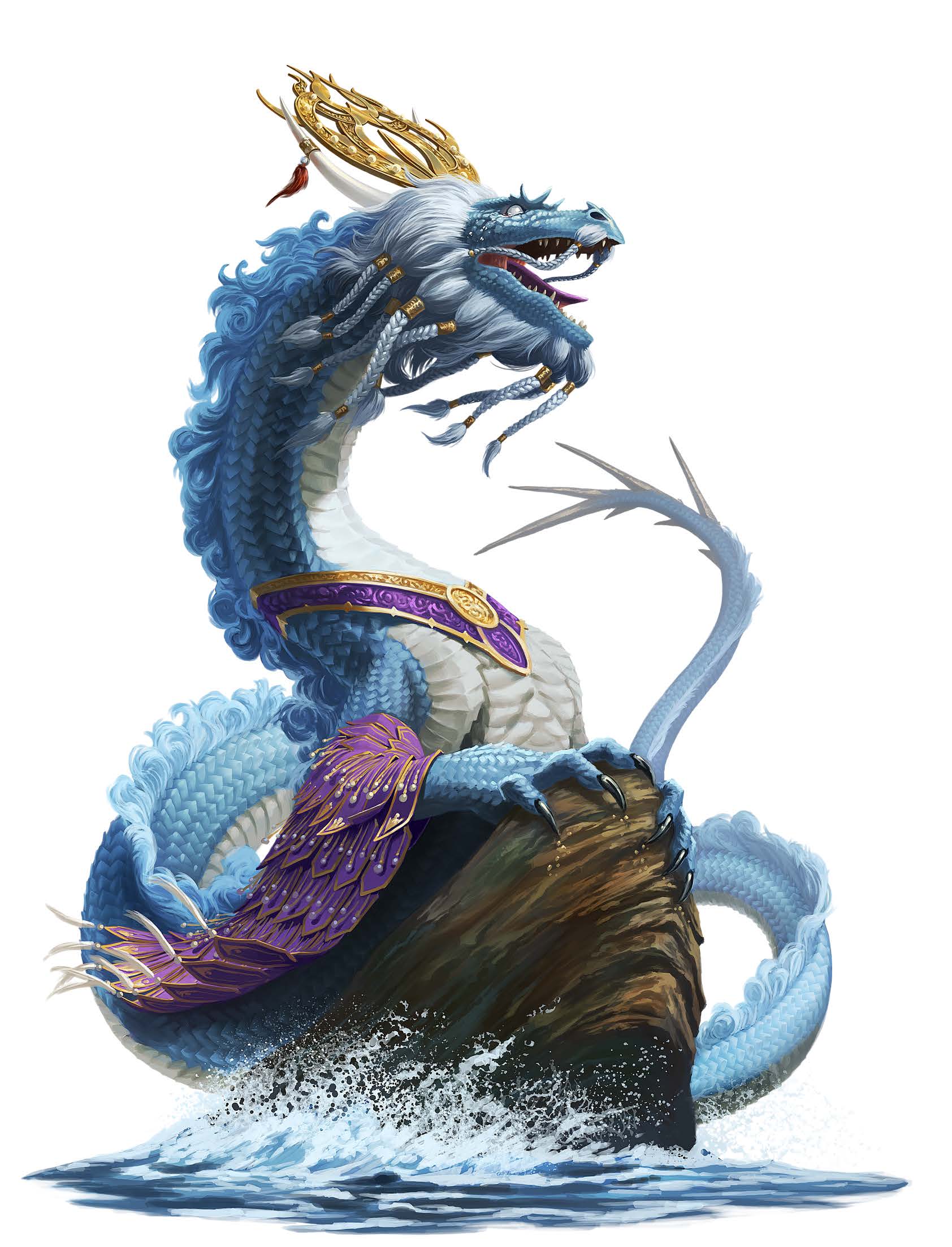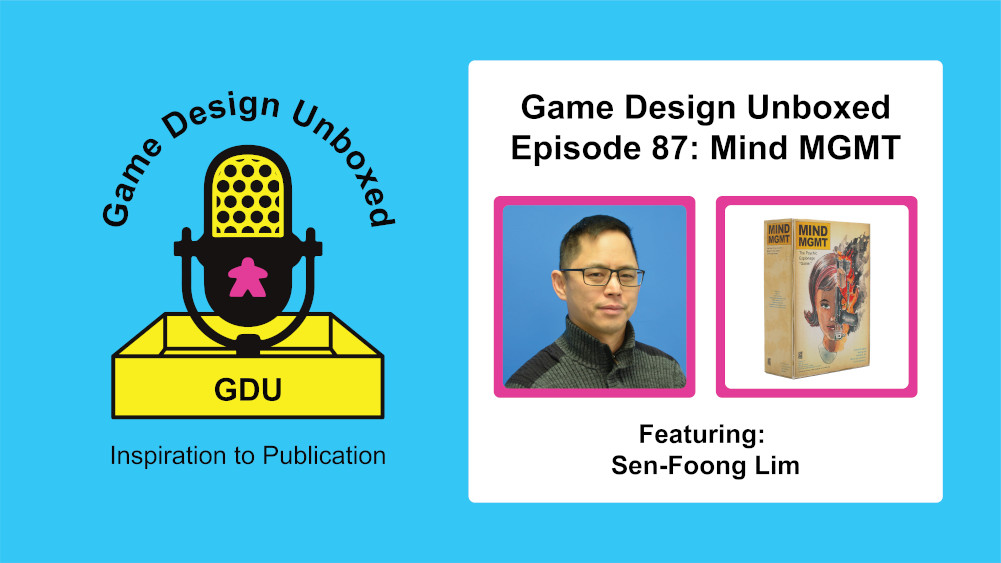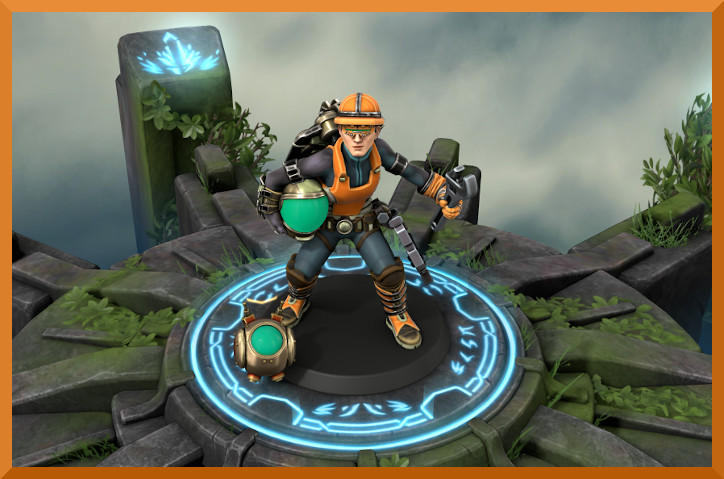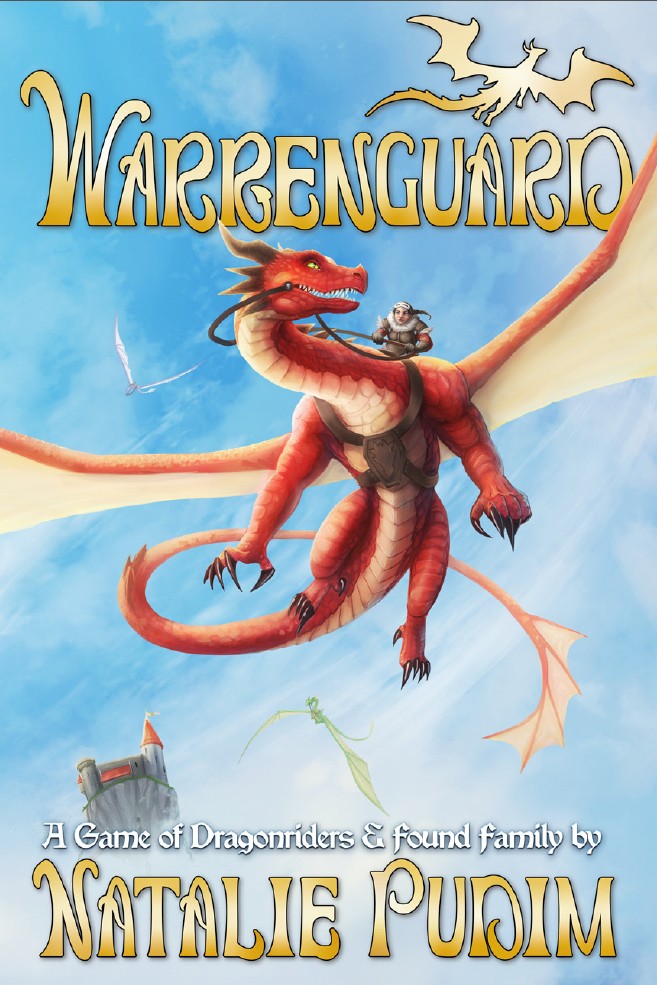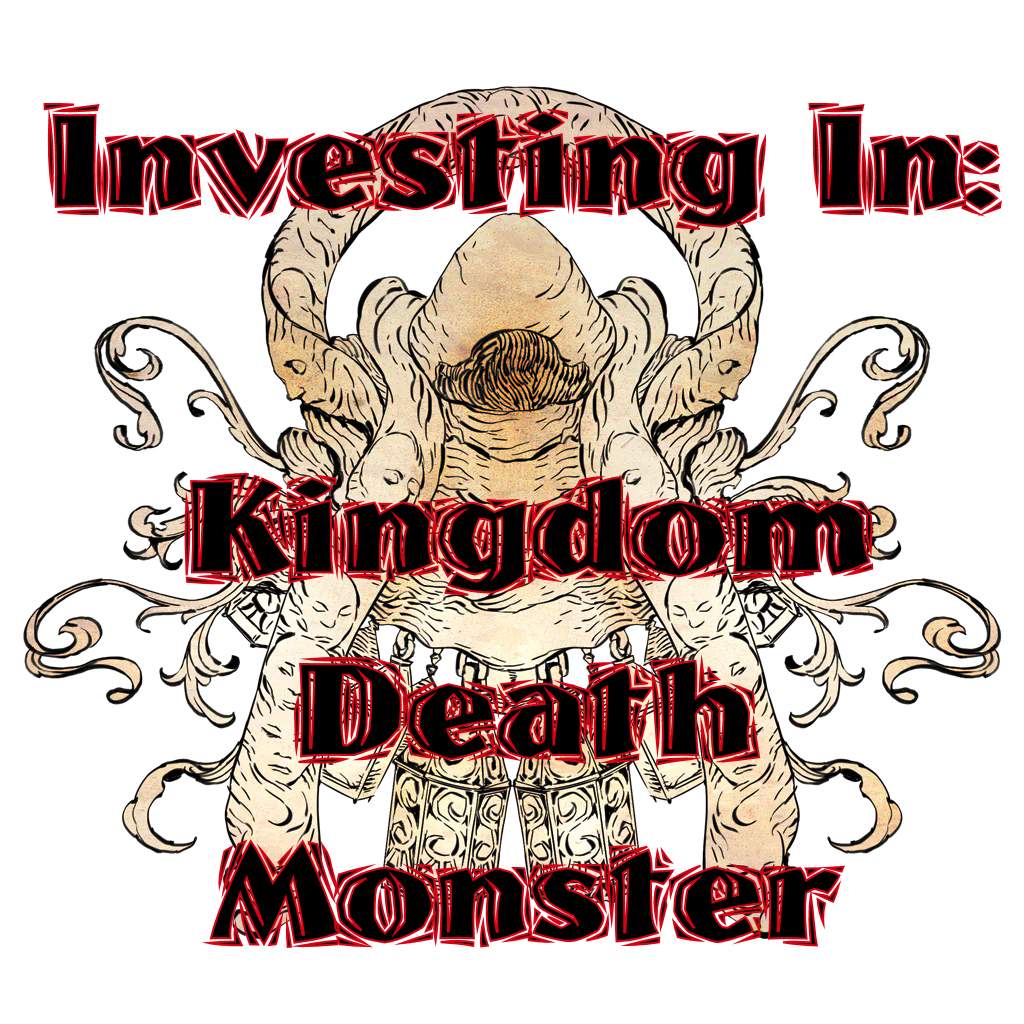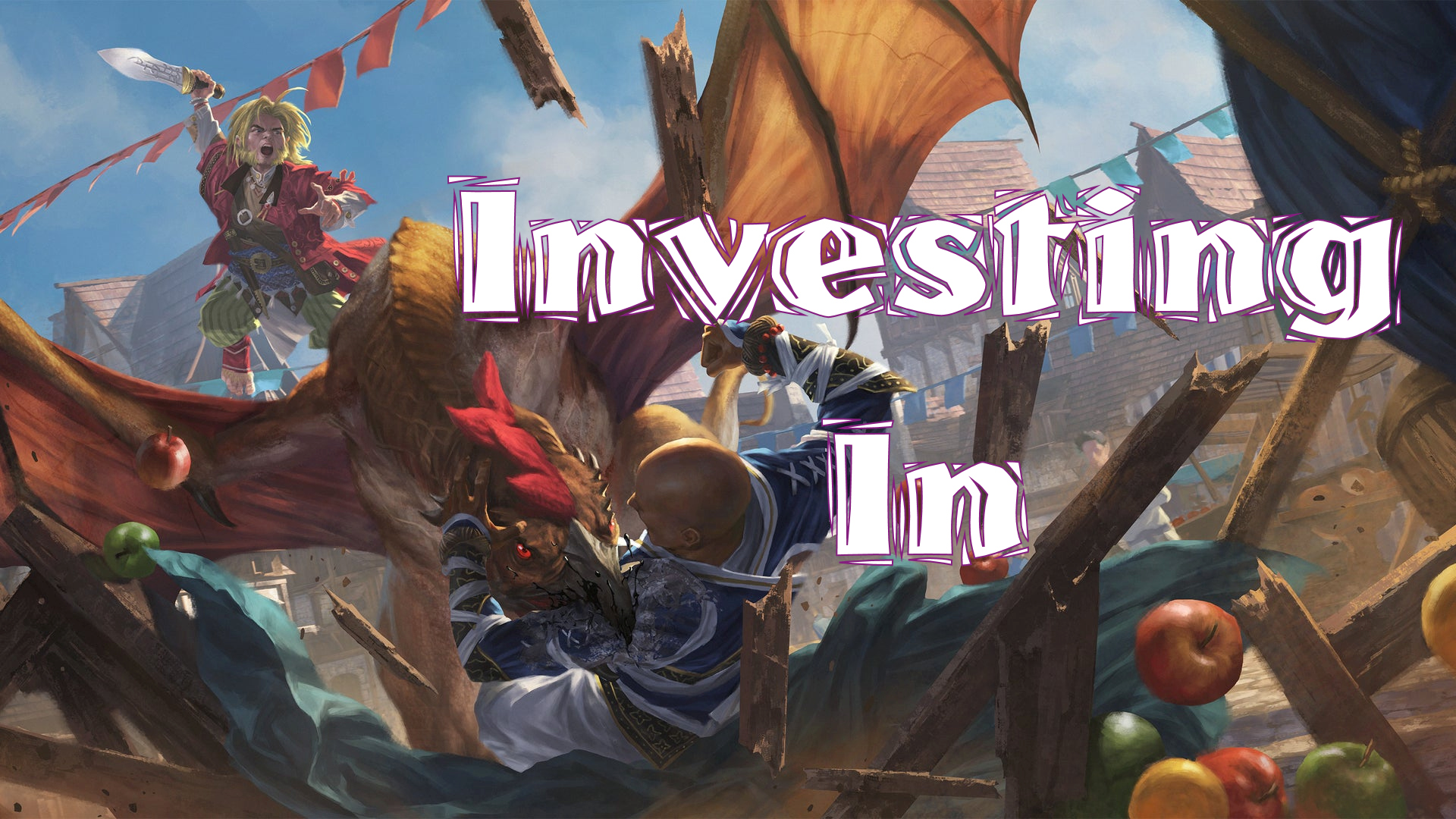“Tian Xia is a vast continent of boundless diversity. Its lands range from the lush vegetation of the Valashmai Jungle to the arid steppes of Hongal, from the undersea depths of the Aya-Maru Trench to the sky-piercing peaks of the Wall of Heaven. Its inhabitants include mighty dragons and the humblest awakened house spirits; families who have dwelled here since the ancient dynasties of Taumata, Yixing, or Shu, to Avistani migrants and their children in the modern era—all equal in their Tian identity. Its gifts span beyond those that might immediately spring to mind—teas, silks, spectacular fireworks—including many so commonplace that those from other lands might forget they’re Tian: oranges, goldfish, and paper pages with printed letters.
Tian Xia can’t be summed up in a single book; no land can.”1
It’s the truth. Despite the 299 pages (before glossary) of the Tian Xia World Guide, the newest Lost Omens release from Paizo, there’s still clearly so much to this continent of Golarion. Much like the Mwangi Expanse (June 2021), Impossible Lands (November 2022), and High Helm (June 2023), this release shows rather than tells that there’s far more than could ever be summed up in one book. Yes, we learn of the countries, the geographies, the actual lands of Tian Xia, but it’s the history of these peoples and their cultures that are brought to light in vibrant ways. With thanks in mind, I do wish I could cover this entire book, every section but I can’t while doing it justice anyway. Next article will do some deeper lore dive, so let’s take a review of all that’s been created and shared with us.
I’ll note too, we want to remember to be respectful. I’m just a cis white guy over here enjoying the amazing creativity and storytelling (as well as the fab art), and I say that because Tian Xia was made to celebrate cultures and communities I’m not a part of. There’s a learning aspect as we honor what’s being shared with us. Many of these creators are bringing their history, their culture, their traditions to us. Thus, it’s important before we play with that bounty brought to us in this book (or any of the cultural tomes of Lost Omens) that we take a moment to do some research into real-world inspirations. I truly do love and am thankful for the way this is done with Paizo books. For me, I’ve long seen myself in media, fantasy, literature, on TV… Again, white dude. But the moment I started to see gay men and LGBTQIA+ friend groups, especially of diversity (and again, not just white gay dudes), I felt encouraged and excited. Surely, others must feel this way and I hope the Lost Omens line continues to do that for others.
Amazing Authors & Artists
That’s why I’m thrilled to see those involved in the book right there on the Table of Contents contributors sidebar! Michael Sayre and James Case are the designers, with James at the lead. Luis Loza, Landon Winkle, and Eleanor Ferron are the developers with Eleanor at the lead. And take a look at that author list and the artists! Please take some time to go learn of these individuals. I started with the first name. Eren Ahn (they/them) is Korean-American who (and I love how they phrased this) “loves to use science fiction, fantasy, and horror to poorly mask their thoughts on various social issues, including but not limited to colonialism, LGBTQ+ rights, and racial injustice.”2 How can you not be excited to see what they’ve shared with us through the bountiful playground of Golarion? I hope I can learn what they wrote; maybe they’ll see this and let me know. Because of twitter (yeah I’m still on there while the gaming community remains) I’ve caught a few as they were shared by James or Luis. Jeremy Blun – who we’ve had on the podcast before – wrote the nation of Linvarre and more, like turning Desna into Mothra (see tweet) but let’s touch on that later! I don’t know when I first learned of Banana Chan (she/they/he) – Kids on Bikes maybe? – but I grinned seeing them listed. Also on twitter, I found Connie Chang (they/he/she) wrote Quain. The dance martial arts mix really got my attention and so did this PbtA-inspire game they’re working on called Godkiller! Thrilled to see Dana Ebert (she/her) doing more. You may recall me gushing over Material Changes in the Grand Bazaar. Viditya Voleti (he/him) has a number of games up on itch.io; I want to play Apprentice Quest about freshmen wizards at college. Our own John Godek III is in there too. I might have to do another article just on what all these fab people are doing as there’s so many fine authors; I encourage you to invest some time in learning about them too! EDIT: Check out today’s Paizo blog post to hear from some of the authors!
On the art side, Ekaterina Gordeeva has returned for the cover like they’ve done for many of the Lost Omens books. There’s many fine artists for the interior. But did you see this? Gunship Revolution. Specifically Mico Dimagiba, Patsy Lascano, Adelijah Ocampo, Luisa Odulio, Hinchel Or, and Brian Valeza are noted as part of this group. Check out their site; they’ve basically worked with most big names I could think of. Previously I haven’t seen individual attributions for Gunship, so I’m glad that’s done here even if it’s not for the specific art. Eventually I know we can go searching and usually find who did what from artstation and the like; I understand individual attribution of authors and artists would be a ton of work. Certainly as a whole, the art in the Tian Xia World Guide is beautiful and inspiring. I’m so thankful for the continent map too! Do let me know if you are or know who the artist is for any images featured here please!
Learning About Tian Xia
Starting with the Introduction I love this Five Tips for Tian Xia section! It dispels some classic tropes like Celestials aren’t always good. Alignment’s gone y’all and holy doesn’t mean good (have you seen Hazbin Hotel?). Appearances can deceiving should be something we all understand but the call out of shapeshifters like kitsune and the goblin dokkaebi might be tricking you. Spirits are real, vibrant, and able to called by some. There’s a whole philosophy about them Ill note later. Dragons aren’t monsters but people, individuals that have been guardians and rulers. Diplomacy not hostility folks! And last, the dead are never truly gone. They’re with us in my opinion and in Tian Xia too. Your ancestors may have been judged by Pharasma, but they didn’t go on to their final reward. Reincarnation is real. This is another philosophy we’ll see later.
The History section is of course full of lore! The Age of Monsters saw kaiju running over the land while the extremely tall Valashai took over the so-named now jungle area of southern Tian Xia. Qlippoth and celestials warred but eventually came the dragons, literally the Age of Dragons, setting up the society we’d see going forward. Earthfall is known as the Age of Ashes (not to be confused with the so-named adventure path) as sea levels rose, greatly changing the continent. Entire empires fell, draconic or humanoid alike. More recent events go on to be detailed with a full sidebar across the seven pages of historical information. The events of the Jade Regent and Ruby Phoenix Tournament are noted, along with their ramifications. Even Ironfang Legion is detailed as Oprak creates diplomatic relations on the continent. I highly encourage any GM to read carefully through the history in order to know better this region and to understand the journeys of its cultures before running any Tian Xia based game. It’s useful information for any PC with an origin there as well, of course.
Tian Xia calls out that dragons are people, rulers and guardians, and there’s an entire Age of their influence. Thus, it’s no surprise there’s an Imperial Dragons chapter introducing us to the role various types of dragons play and some major names. I’m a little shocked that Valashinaz isn’t called out as an Underworld dragon considering their vault, but maybe that’s just because I want more Purepurin. There is a Pathfinder Society scenario for such called Equal Exchanges – Necessary Introductions for that though! I admit being particularly fascinated with the Forest Dragons, maybe because I’m compelled toward visiting forests, but I like that they are natural guardians who are losing ground and may threaten Tian Xia settlements for the sake of nature. Arindham (above) looks rather threatening, but awesome! Luong Phung the sea dragon sounded so cool that I hoped for art of them. How thrilled was I to see such included in the Xidao and Oceans chapter. This book really gives and gives!
A chapter on Factions tells of various groups active throughout Tian Xia. Love that we get our pirate group the Ante, much like the Shackles. The admiral is a ghost who only appears in a storm, which I find interesting considering the storm off the Shackles used to prove one’s mettle. I guess pirates and storms go well together, or is there some sort of blessing on the Admiral by Gozreh? Curse? I’m also very interested in the Way of the Kirin. Here’s a group that was THE good folks of righteous ijndividuals challenging corruption and unified along many avenues. Now it’s in disarray with varied, occasional squadrons and far less organized. Seems a great opportunity for a PC Champion or someone who had a teacher following the Kirin’s ways. Granted the Veils are also interesting with their hoarding of magic, technology, artifacts, and secrets. They think them too dangerous, but are they? The vaults are in Valashmai and we know that area is ancient in its development thanks to the History section. Some great adventures could be had in that jungle, especially defending a vault or needing something from one desperately! If you’re like “wow there’s so much in this book” then yes, you’re right. We’ve only discussed the first 20 pages!
To Temple & School
Religion starts with a general treatise (one page) of the religious tendancies of all those who dwell in Tian Xia. There’s holidays, a pronunciation guide, and also a reference to the recently announced Pathfinder Lost Omens Divine Mysteries! Apparently Hei Feng, Irori, and a few others will have more details there. I’m excited by that cover and the announcement that Arazni will be in the primary pantheon group. It’s about time. Anyway, back to Tian Xia, there’s some mention too of typical shrines and temples but overall how the people of Tian Xia are very much “polytheistic, but also syncretic and pragmatic.” Syncretic’s a new word for me, meaning characterized or brought about by a combination of different beliefs or practices. There’s a great depth of diversity in Tian Xia, made clear by the numerous deities listed. First, the authors take us through the Creation Myths of the continent starting with one featuring a giant dragon egg made of chaos floating out in the universe. One deity I was excited to see is Daikitsu, Lady of Foxes (above), a good-natured if mercurial being with special veneration in Tian Xia’s pantheon due to her fostering agriculture and craftsmanship, important to a civilized society. “To Daikitsu, a beautiful world is one that flourishes.” I love how broad that is. Not the individual. Not the empire. The world. I’m glad kitsune take inspiration from her; perhaps there’s hope for others yet. Shizuru and Tsukiyo I only learned about recently. The former is the god of the sun while the latter is the god of the moon, who was returned from death by his lover Shizuru. Of course there’s family squabbles even in the deities and it was Tsukiyo’s brother Fumeiyoshi, lord of envy, who killed his younger brother perhaps out of jealousy, perhaps because of Tsukiyo selfishly hoarding Shizuru’s light. If you get a chance to ask them, let me know. There’s many more to speak of but I had to call out that Jeremy Blun (author) did indeed get to make Giant Mothra Desna (below). In Tian Xia, Desna is often associated with the silks harvested from silk-producing moths by temple monks, weaving the silk into garments. Hence she is often depicted as a giant moth! An amazingly cool bit of lore to add for her, thanks Jeremy!
I really was intrigued seeing the Philosophies chapter and love its addition. It follows Religion but it’s not about religion. This section details a number of “ancient schools of thought” that have survived the ages with various peoples across Tian Xia. They’re a mix of beliefs, how to approach the world, and an understanding of how the world works in general. It’s not an organized system, so even certain schools of thought can vary between countries or even individuals. I think this is a great add because some players try to express how their characters feel/interact with the world without it being a religious item. As an example the Teachings of the River is also called Sangpotshi and believes in a mingling of souls in death, flowing along the River of Souls until they are reborn but over time those souls can grow and eventually have reached a point of no longer needing to go through a mortal existence to grow. Meanwhile the Way Spirits focuses on all things having a spiritual representation; they can become sentient and develop their own minds. That seems to mesh well with an Animist’s point of view. I like that it’s a focus on honoring all spirits, giving them respect with a point of nature being a primary representation and how many spirits awaken. I love that philosophy!
A short two pages follows, a chapter titled Tests of Virtue. These are rituals of song, poem, and I think dance as well since Power of the Beasts includes an Athletics check. These are tests of virtue and will that grants benefits to the individual. That Power of the Beasts ritual (level 2) can grant you the Titan Wrestler feat after defeating an enemy two or more sizes larger than you, only one size if you critically succeed at the ritual but then it’s three enemies instead of one. But be warned, the moment you use weapons the benefits end. Perfection of Essence caught my attention (level 10) as it grants immortality or at least, you don’t age anymore. Similar to the Power of the Beasts, is the level 6 ritual called the Unseeing Blade Master (see above). Can you guess what that can grant you? Yep, the Blind-Fight feat. Of course you have to do the ritual, which requires Master Perception and then defeating 20 enemies with your sword, or one enemy that uses a sword if you critically succeed. Roll high my friends!
Many Lands to Visit
What follows are over 200 pages of Tian Xia regional information, covering numerous countries, forests, mountains, the oceans, and more like the Darklands. There’s also more than 20 pages of new Bestiary entries before the Glossary, and yet you still can’t sum all of Tian Xia up in one book. However, I will spotlight a few countries. Chue Ye is the land of the Oni, even if most of the population is human. Acupuncture began here, leading to a growth of culture favoring education, medicine, and kind-hearted individuals. Unfortunately corrupt nature spirits came from the Forest of Spirits to the north, imitated the humanoids living there, took advantage of the kindness, and took over the place. There’s the ruthless Shogan Tsuneni ruling over it and the dazzlingly beautiful (that art below) Inma fighting the Underworld dragon Zhulong, resulting in geographic and monstrous unrest! I feel for those people, but thankfully they’ve got the Mizu Ki Hikari resistance. Hopefully the five leaders can work together and secure that alliance with Zhulong. Sure sounds like an adventure path to me! Quick edit shout out to author Grady Wang of The Gallant Goblin (see tweet) who wrote this section. Thank you for the exciting nation and inspiration!
I did mention the Darklands and I have to mention it considering the connections to both Oprak and the elves traveling through it to Jinin. There’s the area called the Clicking Caverns, sitting on the border of nations Xa Hoi and Nagajor, and occasionally clockwork machinery comes shooting out on occasion. That might not be so bad but they’re haunted by the spirits of whatever civilization once lifted in the moving metropolis below called Pan Majang. Could the Jistka Imperium have gone that deep? Or maybe it’s Azlanti that went into the Darklands? Meanwhile General Azaersi of Oprak is using his Onyx Key artifact to connect his people to those of Kaoling for an alliance. Well turns out beneath there was the hobgoblin nation of Rahk Lo who are far friendlier with all humanoids. They’re focused on survival, so collaboration and diplomacy are far more important than warfare. There’s even non-hobgoblin citizens in Rahk Lo, so it’s likely a great place for adventurers to find camaraderie and help fight the foul denizens of the Darklands!
Then there’s beautiful Hwanggot, the Kingdom of Flowers! Its people favor diplomacy and peace and while briefly part of Lung Wa’s tyranny, they’re now celebrating their independence again. What really grasped my attention are the adorable Dokkaebi (above), magical goblins who live there. They have “raucous celebrations” usually around harvest time. They create beautiful earthen pots called onggi, and people like to use them for fermenting food but also treat them as antiques, passing them down through family members. There’s an elder named Chanhee who is well known for her pottery but also for forging legendary blades that can banish spirit and fight fiends! Need your hero to go on a magical sword quest? Time to send them to Hwanggot, partake in a celebration, and impress Chanhee perhaps by rescuing some Dokkaebi from greedy merchants or thieves!
I mentioned Jinin, the forest homeland of elves who traveled through the Darklands after fleeing Earthfall. Here magic and mystery are preserved, as are a number of plants unseen since before Earthfall as they’re gardens are preserved by the elves who fled from Avistan’s surface, traveled through the darkness following the oracle Jininsiel, and emerged in Tian Xia. They followed a vein of dawnsilver and have since woven it into the stonework, their temples, their monuments, and interlaced with the flora they preserve. Elves may be a rare sight in Tian Xia, but their trade of dawnsilver i snot, funding much of the nation. Half-elves are common on the outskirts, and relatively treated like an equal though also like a human. Some of the depth of music and artistry these elves are known for is not shared as much as it could be. There’s a massive Silver Tree that is the center of their capital, Ayajinbo, and is a holy place, though not related to any particular deity. However, it’s worth noting the roots of the tree lead deep into the Darklands as it’s what led the elves to the location in the first place. Thus it must be heavily guarded and usually is. I can imagine an important diplomatic affair and elegant dance party that is interrupted by an attack!
Minkai is a large peninsula nation of relative peace and prosperity, but undergoing a fair amount of civil change since Empress Amatatsu Ameiko took over. Here we see the ramifications of the Jade Regent path as Ameiko has been on the throne for 10 years! Her desire to reduce samurai favorability and prestige, as well as make all who sought positions of power prove their qualifications through exams, postings of experience, haven’t made her incredibly favorable with the nobility. Indeed, some fled to other countries and now watch for weakness. But this badass bard is an Empress of the people, traveling amongst provinces and checking on her nation with a direct approach. She also has her kitsune allies close by including Miyaro who aided her in reclaiming the throne and her daughter Hisae who is the emissary monitoring internal and external threats to the nation, throne, the people. They’re looking for new candidates to help guide the nation including an investigator who specializes in supernatural occurrences and a kobold sorcerer that knows much of the land’s history, told through oral tradition. Having these popular leaders working together is wise, as those angry families who’ve left could prove a new issue for the Empress!
Finally I’ll bring up Xidao and the Oceans of Tian Xia, though there’s an Oceans chapter right after this one. Xidao is an alliance of over 50 city-states, aquatic ones! They’ve always venerated sea dragons like Luong Phung (see below) but what brought them together was the horde of monsters awakened by Earthfall and an undead army that grew as time passed. I love that the A Year In Xidao section breaks it up by the seasons including the Season of Storms (late summer into autumn), Season of Change (late autumn to spring), and the tranquil Season of Tranquility. There’s a big Festival of Arts, hosted by the Shelyn clergy. While the craftsmanship and performance contests are interesting, there’s also a big diplomatic meeting during that festival called the Convocation of the Grand Council. That also sounds like a perfect event to use in your adventures, or put square in an adventure path. Xidao is the nation of waters west of Minkai, so it’d be easy to tie some things together there!
Explore Tian Xia
I could go on and on because this book is a delight. Maybe you can’t sum any land up in one book, but wow do they try! I heavily encourage you to invest in the Tian Xia World Guide! Also, the news broke for the War of Immortals and the various tie-in products from the Godsrain event. Were you following the Godsrain Prophecies? I have to say, I did not think it would be Gorum that’s due to die, but the ramifications of having no deity holding the portfolio for war seems both a good thing at a meta level but also an exciting one for all those chasing to scoop up some of that power, especially in the wake of the Godsrain. I can’t wait to learn more, and next article will dig into some juicy lore bits from Tian Xia. I love these Lost Omens regional books.
And thus, in closing, I have to ask: Arcadia? Luis? Please?
Investing In:
I wasn’t quite sure what to name my article series when I first started but the idea of showcasing or discussing things that make me excited, that I find new and interesting, or maybe I’m otherwise passionate about seemed to fit with the idea of Investing In something like the Pathfinder 2E mechanic. To use some magic items you have to give that little bit of yourself, which helps make these things even better. I like the metaphor of the community growing and being strengthened in the same way!
I also want to hear what you’re Investing In! Leave me a comment below about what games, modules, systems, products, people, live streams, etc you enjoy! You can also hit me up on social media as silentinfinity. I want to hear what excites you and what you’re passionate about. There’s so much wonderful content, people, groups (I could go on) in this community of ours that the more we invest in and share, the better it becomes!
Sources
Banner – Tian Xia World Guide cover, Paizo, art by Ekaterina Gordeeva
- Introduction excerpt, Tian Xia World Guide, Paizo
- Xa Hoi chapter banner, Tian Xia World Guide, Paizo, art by Luis Salas Lastra
- who am I? excerpt, Eren Ahn website
- Arindham, The Imperial Dragons chapter, Tian Xia World Guide, Paizo
- Daikitsu, Religion chapter, Tian Xia World Guide, Paizo
- Desna the Mothra, Religion chapter, Tian Xia World Guide, Paizo
- Inma, Chu Ye chapter, Tian Xia World Guide, Paizo
- Dokkaebi, Hwanggot chapter, Tian Xia World Guide, Paizo
- Minkai chapter banner, Tian Xia World Guide, Paizo, art by Sammy Khalid
- Luong Phung, Xidao and the Oceans of Tian Xia chapter, Tian Xia World Guide, Paizo

